Lifestyle
STA, 30 July 2020 - Slovenia's residents are among the most satisfied in the EU in terms of inter-personal relations, a survey by Eurostat released on Thursday shows. The average mark for satisfaction in Slovenia on a one-to-ten scale is 8.6, well above the EU average of 7.9.
The only other countries in the EU to reach this rate of satisfaction with inter-personal relations are Austria, Malta and Ireland.
On the other side of the spectrum are Bulgaria with the mark of 6.6, which is below Greece (7.1) and Croatia (7.5), with 1 meaning complete dissatisfaction and 10 complete satisfaction.
Overall, satisfaction with inter-personal relations in the EU has not changed much since 2013, when it stood at 7.8. It has increased in 19 EU member states in this period, the most in Bulgaria (by 0.9). In Slovenia, the increase was 0.3.
STA, 30 July 2020 - The Slovenian contact tracing app will be localised and uploaded to GooglePlay and AppStore by Saturday, the deadline for the app to be up and running under a relevant contract, said the Public Administration Ministry on Thursday. The app is operational and currently being tested by the ministry and National Institute of Public Health (NIJZ).
The app #OstaniZdrav (#StayWell) is expected to be available for download in mid-August or the second half of August, given the experience by other countries which also based their contact tracing apps on Android and IOS mobile operating systems, said Peter Geršak, the ministry's state secretary at today's coronavirus briefing.
Saturday marks the deadline by which the app must be localised on the basis of the German Corona-Warn-App under the contract the government signed with developer RSteam, said Geršak, highlighting that the app would help stem the spread of the coronavirus and urging citizens to use it.
The institute and ministry (MJU) are currently testing the product to ensure the internalisation of the open-source app has been done right and to assess its operations, functionality and information security.
Primož Cigoj, RSteam director and a researcher at the Jožef Stefan Institute, said today that #OstaniZdrav would be easy to use and would require no special skills. After downloading it, the user will get instructions on its use and activation will be only one click away.
"The app requires nothing of you. If you get infected, you enter a 10-digit code given by an epidemiologist, and even that is voluntary," said Cigoj.
![]()
The logotip of the app
#OstaniZdrav will warn the user about the level of risk of contracting the virus using three colours - green will represent low risk, blue an unknown state indicating relevant data is still being gathered, and red increased risk, meaning contact with infected persons.
Both Cigoj and Geršak said that the issues experienced by the German app regarding exchanging data have been resolved in the Slovenian version.
The state secretary pointed out that the app would not be used for geolocation data tracking and would not have access to any personal information stored on the phone which could give away the user's identity.
The Information Commissioner has not yet given the final go-ahead for the app, said Cigoj, but he does not expect any problems. The app is currently available only in Slovenia, he added.
Later in the day, Information Commissioner Mojca Prelesnik reiterated that the legal basis for the introduction of the app was inappropriate.
The ministry's outcome estimate regarding personal data protection which did not stem from the relevant law is not enough to mitigate the shortcomings of the legislation, she said, adding that such a document should have been drawn up before endorsing the law.
She pointed out that the standpoint of all European data protection watchdogs on such legal bases was the same in that respect.
STA, 30 July 2020 – Poor wine sales brought on by the coronavirus lockdown not only affected the pockets of winemakers but at least in one case appear to be bad news for the environment as well. After fish began to die off in a stream near Gornja Radgona and other animals were seen behaving as if drunk, analysis showed high amounts of sulphur and alcohol in the water.
Since Monday, local anglers in Gornja Radgona, a town in the idyllic wine country of Slovenske Gorice, have been retrieving dead fish from the Lisjakova Struga stream, a tributary of the Mura river.
While the fish likely died from sulphur molecules tying to the oxygen in the water, analysis conducted for a fishpond feeding from the stream on Monday showed alcohol level as high as 0.47%, while alcohol content in the stream was 0.35%.
The local angling association suspects that somebody had dumped large amounts of wine in the stream or had been cleaning barrels with alcohol and sulphur. Their suspicions stem, in part, from the fact that wine sales tanked during the Covid-19 epidemic.
Franek Radolič of the angling association told the STA that truly large quantities had to have been dumped into the stream considering that the waterway is over 1.5 kilometres long. The association took immediate action, liming the pond and taking measures to raise oxygen levels, but to no avail.
Radolič said that oxygen levels in the water had dropped significantly; whereas there are usually between 5mg and 6mg of oxygen in a litre of water, the levels in Lisjakova Struga dropped to a mere 1mg.
The anglers also said that animals drinking the water from the stream had been behaving unusually, as if they had been drunk, the newspaper Slovenske Novice has reported.
Although a report has been made to the police and the relevant Environment Inspectorate, the anglers doubt that a culprit will be found for what they say is not the first such incident.
STA, 29 July 2020 - Two young Belarusians pulled over by the police near Semič close to the border with Croatia on Tuesday evening were found to be carrying a total of ten Moroccans in two vehicles with Polish license plates in what is but the latest in a series of similar incidents reported by the police.
A press release from the Novo Mesto Police Department said the Moroccans had entered Slovenia illegally.
The two Belarusians, both aged 21, will be brought before an investigating judge, while proceedings involving the migrants are still ongoing.
Slovenian police handled 4,993 attempts at crossing the border illegally from January to the end of June, a decrease of 12.4% compared with the same period last year, a fall blamed on the pandemic loockdown and border restrictions.
The cases were up in May to 903 and surged to 1,689 in June, which compares to 1,200 in the same peak month last year.
More than three out of four illegal migrants handled by the police in the first half of the year were citizens of Morocco, Pakistan and Afghanistan.
A total of 1,766 migrants expressed an intention to seek asylum in Slovenia, while Slovenian police returned 3,118 foreigners to foreign law enforcement authorities, 3,100 of them to Croatia's.
STA, 27 July 2020 - The Constitutional Court has stayed implementation of a municipal decree amending the naming of streets, squares and villages in the Radenci municipality until there is a final say on a referendum proposal launched by locals who oppose renaming a road that bears the name of the former Yugoslavia's communist leader Tito.
In late May, the local council of the spa town of Radenci in the north-east decided on the initiative of Radenci Mayor Roman Leljak that Titova Road shall be renamed to Slovenian Independence Road.
Some locals do not agree with the decision, saying that the name Titova Road reflects a historical fact and that the renaming efforts are but a provocation attempt by the mayor.
Leljak responded to the decision on Facebook, saying that the "Administrative Court is also deciding on the procedure and, to me personally, it does not make sense that the Constitutional Court has skipped the Administrative Court."
Is this a matter of distrust in the Administrative Court or an agreement between the courts, which would be a grave violation of the principle of legality", he added.
Leljak said he would probably propose to the municipal council that the decree renaming Titova Road be annulled, and that a referendum be held in which the name of the road would be decided on.
He believes the referendum could be held in the spring of 2021.
The mayor also noted that the procedure was causing the municipality much costs with legal fees, and that it could take a year or more. "The cost of referendum would be considerably smaller than the cost of litigation."
The Constitutional Court has determined that staying implementation of the decree could not lead to major repercussions, taking into account the fact that the name Titova Road has been in use since 1979. The road was named after former communist leader Josip Broz Tito (1892-1980).
In the event the court did not stay implementation and the decree was to be later annulled due to it being unconstitutional, the locals as well as the municipality could suffer from unnecessary expenses. Moreover, the potential ramifications of implementing the decree would surpass the potential repercussions of its staying, said the court.
The decision was passed on 1 July in a 7:2 vote.
In 2011, Slovenia's top court ruled unanimously that the 2009 decision of the Ljubljana city council to name a street in the capital after Tito was unconstitutional given that Tito's name symbolised the former totalitarian regime and that naming a street after him could objectively been seen as a recognition for this regime.
STA, 24 July 2020- The Jožef Stefan Institute (IJS) has created a new model for forecasting the spread of the coronavirus. The institute estimates that the number of new cases is growing at an exponential rate - the figure doubles in 35 days, whereas the effective reproduction number is higher than 1, which means that "the epidemic might be getting out of hand".
In the coming period, between ten and 35 infections will be confirmed per day, projects the country's top research institute.
The institute says that the impact of imported infections is no longer relevant since the spread within the country has taken central stage now.
The seven-day average of the effective reproduction number - the number showing to how many people the infected person transmits the virus, currently stands at 1.16, whereas the three day-average is 1.55, warns the institute.
The IJS came up with four different scenarios of the epidemic unfolding, depending on the week-long average of the effective reproduction number.
If the figure was 1, meaning one secondary case per infectious case, the national death toll would increase to almost 150 by the end of September, the number of those hospitalised with Covid-19 would remain under 25 and the number of those in intensive care under 10.
Provided the effective reproduction number remained at 1.1, then the number of hospitalised Covid-19 patients would grow to nearly 50, the number of those requiring intensive care would be slightly bigger but still under 10, whereas the death toll would increase to more than 150.
In case an infected person spread the virus to 1.3 persons, 25 people would be in intensive care, close to 160 people would be hospitalised by late September and Slovenia would record almost 200 Covid-19 related fatalities.
In the event that the relevant figure stood at 1.5, same as the current three-day average, some 75 persons would require intensive care, more than 200 would be in hospital already during the second week of September, and the death toll would exceed 200 in mid-September.
Efforts should be stepped up to drive the effective reproduction number below 1 again, which would mean the epidemic is slowing down, urged the institute.
"Given the number of positive tests, the second wave of infections has so far resulted in a 70% decrease in the numbers of hospitalised patients, those in intensive care and the death toll compared to the first wave, presumably due to those infected being younger," said the IJS.
Meanwhile, the Medical Chamber said today that doctors were concerned over the developments, urging everyone to do all they could to ensure that the epidemic does not get out of hand during summer holidays when people tend to be more relaxed.
Doctors also pointed out that suspending health services again due to coronavirus concerns would put at risk many lives. They also called for protecting vulnerable groups.
Other health officials also expressed concern and called on citizens to behave responsibly, including National Public Health Institute (NIJZ) director Milan Krek and Bojana Beović, the head of the Covid-19 advisory team at the Health Ministry.
Krek told the STA that the virus was now primarily spreading from mass parties, and also from companies. "You can marry in these times, but you don't have to invite 200 people," he added.
If the number of infections starts to grow exponentially, the NIJZ will propose additional restrictive measures to the government, including limiting opening hours of shops, bars and restaurants.
What epidemiologists have noticed is that the number of infections is increasing also because infected persons do not want to reveal their contacts, Krek said, also inviting people to get tested if they have symptoms.
If the trend continues he said measures would be necessary because the capacity of the Slovenian healthcare system was limited and the authorities wanted to prevent other segments in the system from grinding to a halt.
Beović also said that the projections by the IJS were not so good, adding that the number of infected persons in Slovenia was going beyond the boundary which had been though to be manageable.
She too mentioned limits on bars and restaurants as one of the possible measures if the growth gets exponential, while measures on borders in order to prevent imported infections are also possible.
Beović said that complaining about the mandatory use of masks and hand sanitation is "nonsensical and unethical at this moment."
"If we do not adhere to this, we are in for unpleasant times," she told the STA, noting that there would also be "economic damage which will also impact human lives".
All our stories on coronavirus and Slovenia, while up-to-date statistics can be found here
Recently one of the most exciting new luxury cars on the market, the all-electric Porsche Taycan, has joined the fleet of the Slovenian car rental agency Actinia. The car is thus now available to sports and luxury car enthusiasts for a short- and long-term rental.

The long-term car rental business was developed as a way of avoiding the responsibilities of car ownership and leasing, with significantly lower monthly rates that include all services such as basic and full comprehensive insurance, regular servicing and maintenance, winter and summer tires, vignette, roadside assistance, a replacement vehicle and alike.
All of this proves useful for companies and individuals, who would prefer not to deal with the responsibilities of car management and service or would like to know a car better before making a purchase. The latter is perhaps much more important with regard to luxury cars, a growing market which also includes the sharply growing, albeit much smaller, market for supercars.
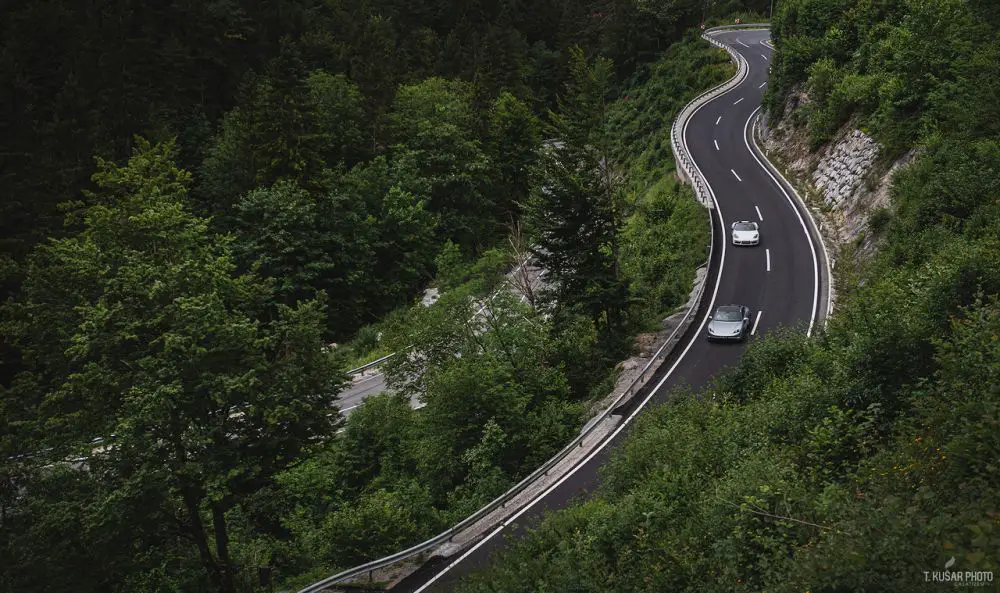
In this respect, certain interesting things are happening in the luxury car market, with Porsche Taycan representing the latest of exciting development. Firstly, Taycan won the 2020 World Car Awards in two categories, as the World Luxury Car and World Performance Car of the Year. Secondly, Taycan is the first all-electric Porsche, and thus has inspired much debate as to how it compared with the Tesla Model S, as it may emerge as challenger to Tesla’s current dominance in the field of luxury electric vehicles.
Although Porsche R&D boss Michael Steiner has tried to avoid such comparisons by stating that Porsche does not compete in the same segment of “targeting the volume” Tesla does with more mass-market vehicles like the Model 3, and therefore he doesn’t consider Tesla a direct competitor to Porsche, the comparisons with Tesla Model S continue.
It is therefore even more exciting to know that Porsche Taycan 4S has most recently been added to the fleet of cars available at the Slovenian car rental service Actinia.

Price? With Actinia the Taycan will cost you €207 for a three-hour rental which includes 30km mileage, or €414 per day (100 km), €828 per weekend (300 km), €1,680 per week (700 km), €4,976 per month (3000 km) and €3,900 a month for two year rental.
In case you want to compare it with Tesla Model S, in Slovenia Elon Musk’s car is available with Autobroker at a slightly lower price compared to the Taycan, that is for €366 per day, €732 per weekend, €1490 for a week and €4390 per month.
Both Actinia and Autobroker also offer other, more affordable cars like Volkswagens and Škodas for a long term rental and If you don't find your desired vehicle there, you certainly will with Avantcar, whose website is also in English.
.
STA, 20 July 2020 - A wind farm with a rated capacity of 21.6 megawatts is to be built on a mountain ridge near the border with Croatia, under plans recently endorsed by the Slovenian government.
The government took the decision on 8 July on the implementation of a national zoning plan for six wind turbines on the Maceljska Gora ridge in the area of Rogatec.
The farm is to be built by Dravske Elektrarne Maribor, a subsidiary of the state-owned power group HSE. The type of the production units is yet to be determined but the investor plans technologically advanced units both environment- and efficiency-wise.
The government says the project will contribute to increasing the output from renewables, self-sufficiency of electricity supply and greater diversification and dispersal of energy production sources, all of which is in line with the country's energy policy principles.
The six wind turbines, each with a rated capacity of up to 3.6 megawatts, or a combined 21.6 MW, are to be built in a sparsely populated north-eastern corner of the Rogatec municipality, at least half a kilometre from the nearest settlement.
The wind farm could produce 55 gigawatt hours of power. The units will be connected via a 20 kilovolt cable conduit to the planned Rogatec wind farm substation, and from there by two further cables to the Rogaška Slatina transformer and distribution station.
Each unit is to comprise a tower measuring between 110 and 140 metres in height, and a rotor with a diameter of between 125 and 145 metres. The base with have a diameter of about 25 metres.
Under the national energy and climate plan Slovenia should derive at least 27% of its final energy consumption from renewable sources by 2030. The proportion was at 21.1% in 2018.
Slovenia has 12 locations of various sizes that measurements have shown are suitable for wind farms, but only two wind turbines are in fact in operation - a 2.3-megawatt one and a 0.9-megawatt unit, both located in the south-west.
In 2018 the output of the two wind turbines was equivalent to just 0.04% of Slovenia's energy consumption. They generated six gigawatt hours of electricity.
Despite public support for green energy in principle, opposition to wind farms by environmentalists and NIMBY [ed. not in my backyard] initiatives has been considerable.
Etno HistEeria (from Ethno Istria) is an annual ethno, folk and fusion workshop for international musicians, which culminates in a series of concerts that take place in the municipality of Koper and during the Floating Castle Festival in Snežnik. This year’s concert dates and locations are as follows:
July 23 at 20:00, Koper, Ukmarjev trg: Etno HistEria jam session
July 24 at 20:00, Truške village, under the big oak tree: a concert of EH bands
July 25 at 20:00, Kubed village: concert of bands and the big EH orchestra
July 26 at 20:00, Truške village under the big oak tree: puppets and jam session
July 28 at 20:00, Koper Tavern: Etno HistErija Grand Orchestra Concert
July 29 at 20:00, Truške village: an evening with bands and a puppet caravan
August 3 at 19:00, Koper: Floating Castle at the PUF Festival with Ethno HistEria
You can find more about the Floating Castle Festival, which will take place on August 1 and 2 at Snežnik Castle, and will among other events host Etno HistEria, here.
Due to special circumstances this year the organizers have to follow certain coronavirus safety measures which include the limitation of available “seats”. Everyone interested in coming should therefore first make a reservation by SMS to (+386) 041778061.
Last week saw the return the National Hall (Narodni dom) in Trieste (Trst) to Slovenian hands a century after it was burned down in an act of anti-Slovene violence that’s seen as the start of Fascism. By coincidence, the same day I learned of a new novel about that era, and life in the city that was once home to the largest Slovenian population outside of Ljubljana, His Most Italian City, by Margaret Walker. I sent her some questions, and she was kind of enough to answer…
What’s your connection to Slovenian Trieste?
I was adopted as a baby and my birth mother Silvana (1920 – 2020) was Istrian. It has taken me my whole life to discover her history. She was born in Tar and her father was born in Trieste in 1886. Her grandmother (her mother’s mother) was a Slovenian from a village near the Austrian border. Silvana worked as an interpreter for the Allied Military Government in Trieste after the war. In 1950, she emigrated to Australia.
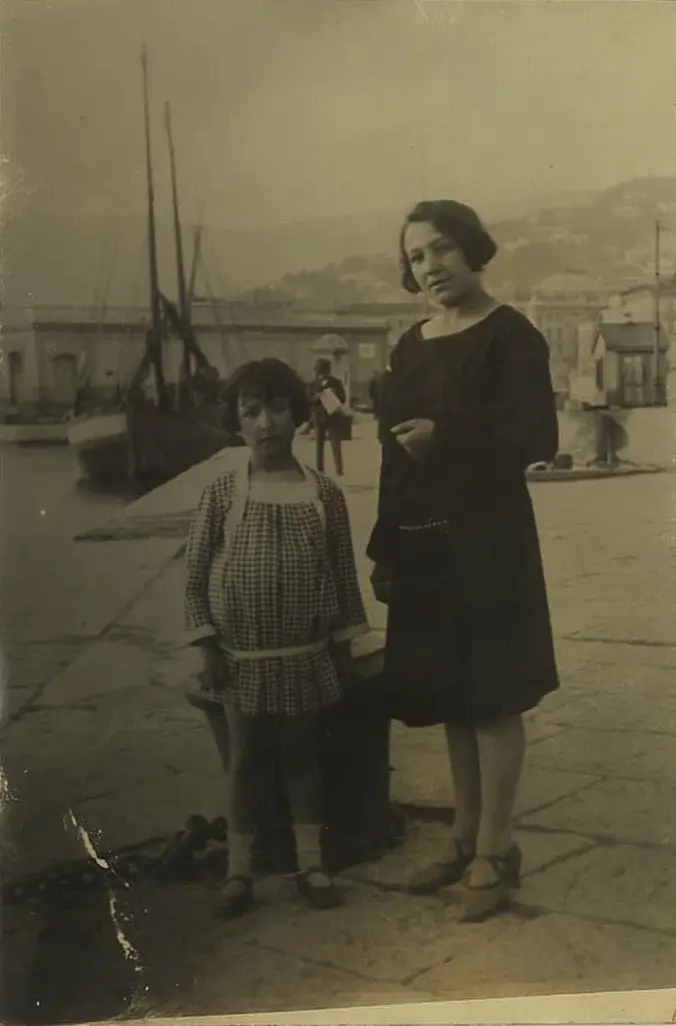
Silvana in 1927...
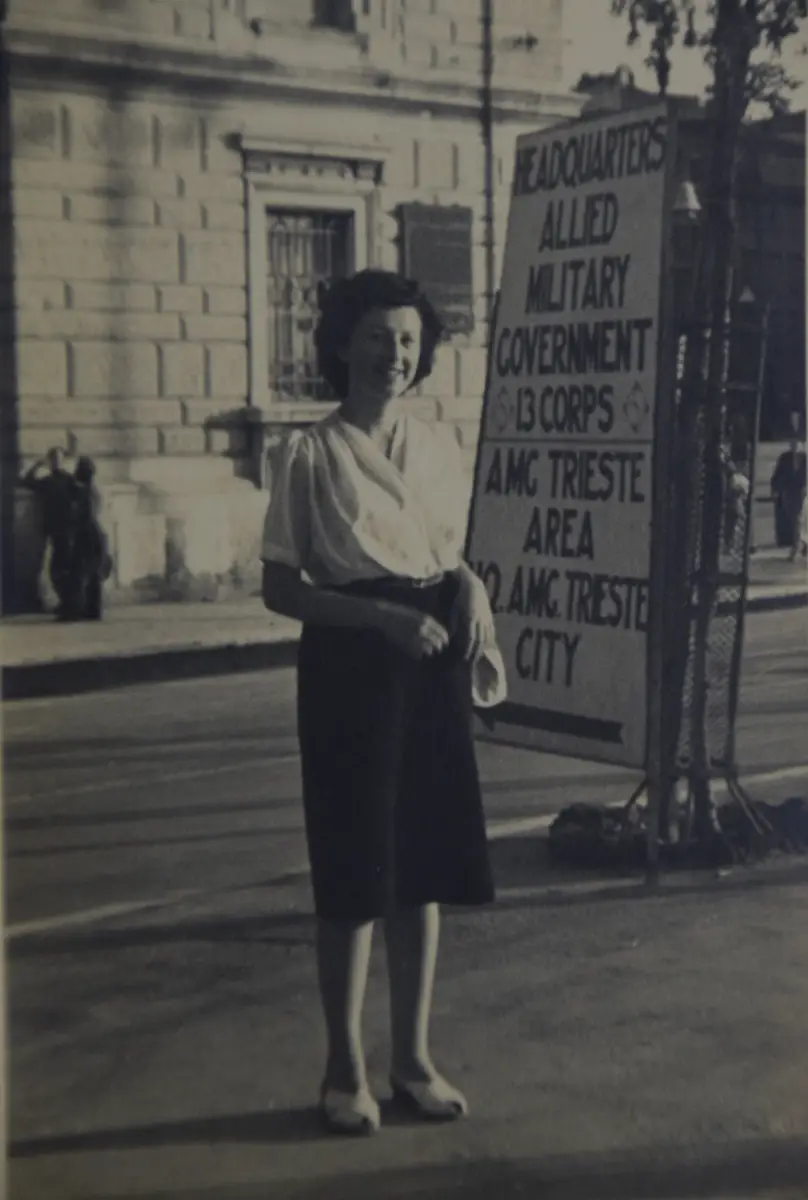
...and in 1947
Of Istria, my mother said, ‘We were Austrian, then Austria lost the war. Then we were Italian and Italy lost the war.’ I believe that she just thought of herself as Istrian. She became Yugoslavian after the war and her parents became Italian. Am I confused? Yes.
What can you tell us about the novel?
It’s a work of historical fiction, and I chose that genre so that the history might be more easily accessible to a wide audience.
The story begins in 1928, because that was when Mussolini’s government changed my birth mother’s family name from Micatovich [Micatovič, Micatovik] to Di Micheli. My original intention was to record what she had told us about her childhood in Istria. Because I love sea stories and submarines, I also wanted to incorporate elements of the Austro-Hungarian navy into the narrative, and I began to read about the modern history of Italy and Trieste. My website contains a selected bibliography.

TIGR logo - Wikipedia
The more I researched, the more evident it became that any story about Trieste in the 1920’s had to include the conflict between Fascist Italy and the Slovenians. I read about the anti-Fascist group TIGR (Trst, Istria, Gorica, Rijeka) and the Fascist attack on the Narodni dom in 1920 and I wondered how I could incorporate these into the novel. This was when I came up with the idea of a group of men working for TIGR led by Stefan Pirjevec, a former submarine captain in the Austro-Hungarian navy whose wife had died in the fire in the Narodni dom. The character is based on my neighbour who was a captain in the Australian Merchant Navy. Sydney Harbour, where I live, is a busy passenger port so, whenever I wrote about the port of Trieste in the 1920’s when it was much busier than it was during my recent visits, I had to imagine that it was Sydney.
What other research did you do?
As well as history textbooks and websites, I read several rare books written in the 1800’s about boat journeys from Trieste. The best was Rambles in Istria (RHR, London 1875). I read Necropolis by Boris Pahor in English and Piazza Oberdan in German. Unfortunately, my German’s not very good, but I did my best.
And what else did you learn in writing the book?
I originally trained in mathematics and science and, as my research continued, I noticed that Italy had a huge population compared to the population of Slovenia: 40 million to 1.3 million. I asked myself why such a large country should have felt so threatened by a Slovenian minority in Trieste.
The answer came from the historian Gianfranco Cresciani. Dr Cresciani was born in Trieste and lives in Sydney. He explained the perils that nationalism could hold for some individuals. I am Australian and Australians are not nationalistic. I found the Italian ultra-nationalism (or Fascism) of one hundred years ago very hard to comprehend, particularly its racism and violence, and its vitriolic anti-Slav propaganda. However, both Boris Pahor and Jan Morris (Trieste and the Meaning of Nowhere) noted that the majority of Trieste’s population were conservative, and didn’t want such radical politics.
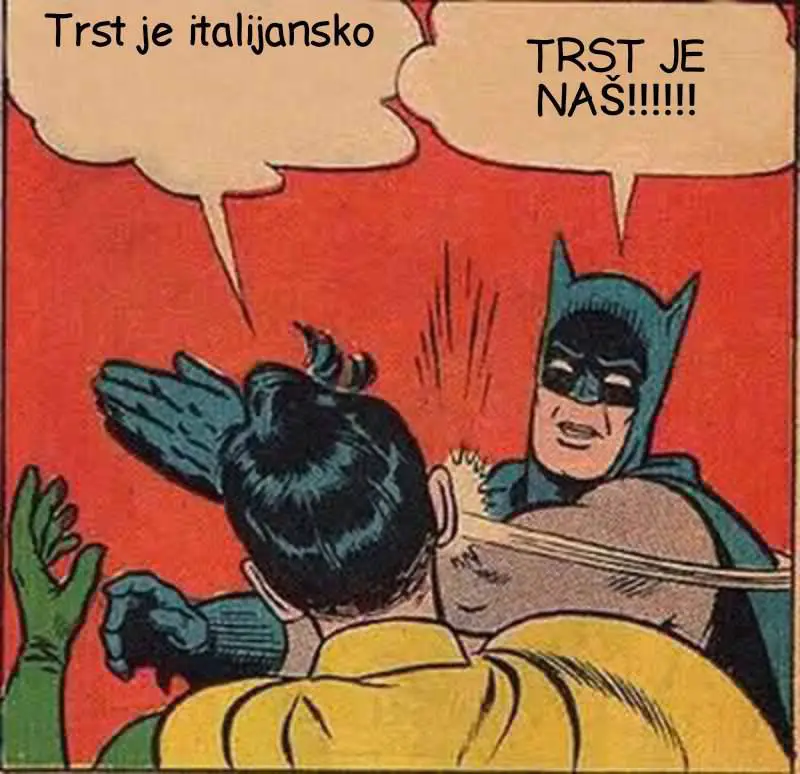
Trst je naš (Trieste is ours) remains popular in Slovenian memes
Finally, what’s the blurb for His Most Italian City, and where can people find it?
First, you can get a copy from Amazon, Barnes & Noble, Smashwords, or direct from the publisher, Penmore Press. You can also see a review from the American Historical Novel Society, and if you’re curious about me I have a website, too, plus a blog that mainly focuses on submarines.
Now the blurb:
Fascist Italy 1928. Trieste, once the port of the Austro-Hungarian Empire, has become Italian. As fascism strives violently to create a pure Italy along its streets, Matteo Brazzi is forced to choose his loyalties with care. When his office is bombed, the police are baffled, but Brazzi knows who committed the crime, and he knows why. Though he is no seaman, he can easily identify the dark shape that disappeared into the Gulf of Trieste that dramatic night and, as he escapes to Cittanova in Istria, the mysterious vessel follows him down the coast. Brazzi has successfully exploited fascism to protect himself - many people would call him a traitor - but he’s only ever had one real love. Now Nataša is dead and Brazzi owes his share of the blame. Too soon he discovers that not even Mussolini can save him from an enemy who is bent on revenge.
Marles kitchens, an icon of quality in socialist Yugoslavia, can still be found in many Slovenian homes today. It is therefore not surprising that after so many years, it is becoming increasingly difficult to replace them.
That their value has risen in time is also evident from advertisements placed on the online second hand market bolha.com, where in the first decade of the new millennium these kitchens were offered for free, if anyone would take them, while at the moment, especially the higher quality orange ones, you need to pay for them, although they are still quite cheap.
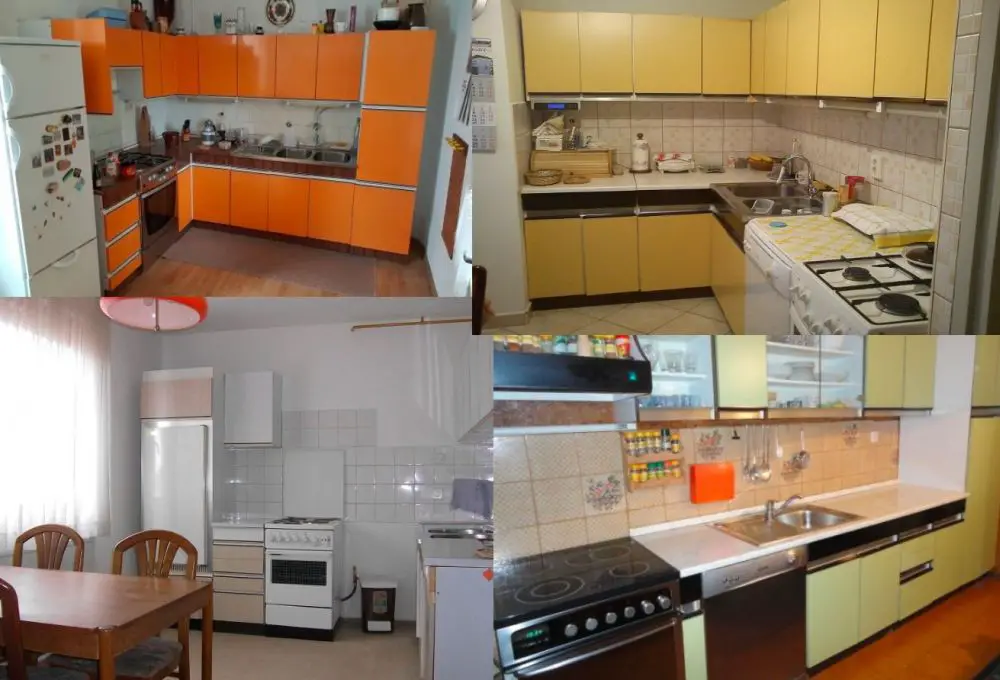
The beginnings of the Marles Company go back to the end of the 19th century and the carpentry of Ferdinand Potočnik. In 1960 three wood companies from the area of Maribor (where the first part of the company’s name comes from) were merged into Marles and began producing furniture (les, the second part of the name, means wood in Slovenian).
Five years later, the company started operating under the same roof in an upgraded furniture factory in Limbuš. According to an agreement between the producers of similar products in the wider Slovenian area, Marles combined several previous lines into one, focusing on the production of kitchen furniture, while Meblo of Nova Gorica was to produce furniture for bedrooms and Brest Cerknica for living rooms.
The company modernized its technology of processing and design and the first success and recognition of its work came with the cocktail 68 kitchen element programme, with several lines which continued almost unchanged for 18 years, until 1986.
In 1969 a Cocktail variant in bright orange was introduced, designed to brighten north-facing kitchens with less natural light. The orange cocktail kitchen became a futuristic space-era hit among the higher class, with bases and worktops covered with a rich brown rosewood veneer and without any use of plywood.
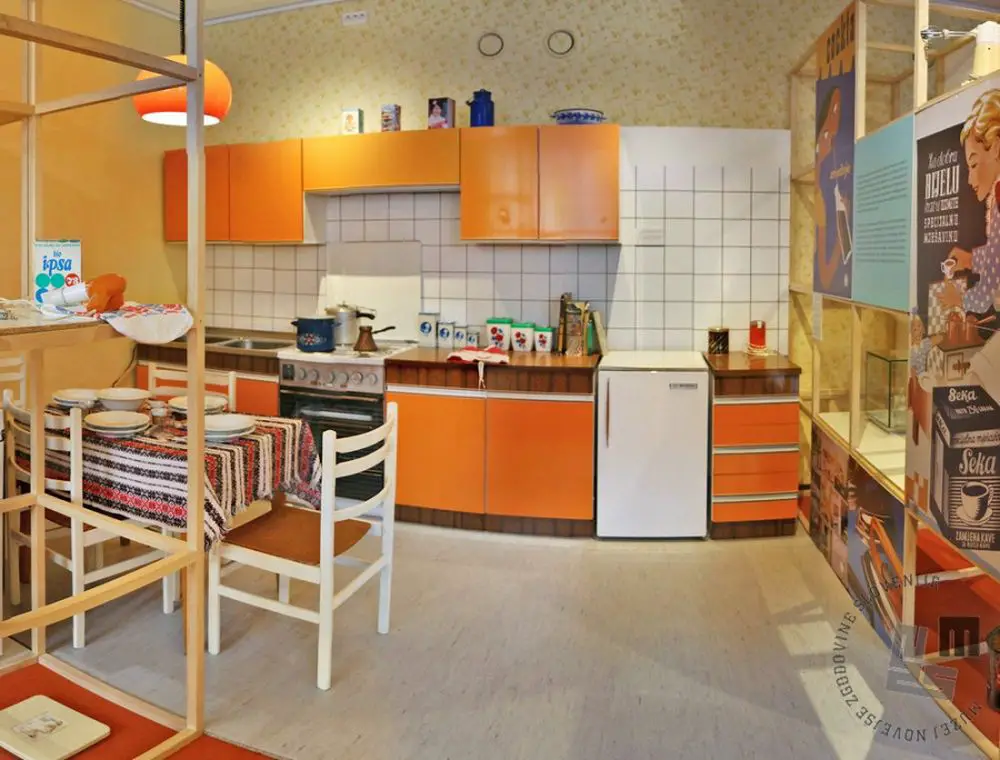
Pictures of Cocktail variant kitchens are preserved by the photographic collection of the National Museum of Contemporary History, which is located in Tivoli Park in Ljubljana.





